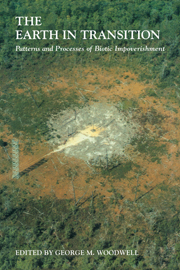Book contents
- Frontmatter
- Contents
- Preface
- Acknowledgments
- List of Contributors
- Part I Global Change and the Patterns of Impoverishment
- Part II Chronic Disturbance and Natural Ecosystems: Forests
- Part III Chronic Disturbance and Natural Ecosystems: Woodlands, Grasslands, and Tundra
- Part IV Chronic Disturbance and Natural Ecosystems: Aquatic and Emergent Ecosystems
- 18 Changes in a Red Sea Coral Community Structure: A Long-Term Case History Study
- 19 Are Deep-Sea Communities Resilient?
- 20 Species Dominance–Diversity Patterns in Oceanic Communities
- 21 Natural and Anthropogenically Imposed Limitations to Biotic Richness in Fresh Waters
- 22 Human Impacts on the South Florida Wetlands: The Everglades and Big Cypress Swamp
- 23 The Impoverishment of Aquatic Communities by Smelter Activities near Sudbury, Canada
- 24 Biotic Impoverishment: Effects of Anthropogenic Stress
- Part V Conclusion: Steps toward a World That Runs Itself
- Name Index
- Subject Index
19 - Are Deep-Sea Communities Resilient?
Published online by Cambridge University Press: 24 November 2009
- Frontmatter
- Contents
- Preface
- Acknowledgments
- List of Contributors
- Part I Global Change and the Patterns of Impoverishment
- Part II Chronic Disturbance and Natural Ecosystems: Forests
- Part III Chronic Disturbance and Natural Ecosystems: Woodlands, Grasslands, and Tundra
- Part IV Chronic Disturbance and Natural Ecosystems: Aquatic and Emergent Ecosystems
- 18 Changes in a Red Sea Coral Community Structure: A Long-Term Case History Study
- 19 Are Deep-Sea Communities Resilient?
- 20 Species Dominance–Diversity Patterns in Oceanic Communities
- 21 Natural and Anthropogenically Imposed Limitations to Biotic Richness in Fresh Waters
- 22 Human Impacts on the South Florida Wetlands: The Everglades and Big Cypress Swamp
- 23 The Impoverishment of Aquatic Communities by Smelter Activities near Sudbury, Canada
- 24 Biotic Impoverishment: Effects of Anthropogenic Stress
- Part V Conclusion: Steps toward a World That Runs Itself
- Name Index
- Subject Index
Summary
Editor's Note: The bottom of the deep sea is dark and cold and a very old habitat by most terrestrial standards. Dr. Grassle and his colleagues have shown that the benthos contains an extraordinary diversity of life with different life histories and adaptations to habitat. A combined sample from 1,500 m to 2,500 m off New Jersey that covered a mere 21m2 yielded 798 species, a diversity that approaches the upper limits of what can be found on land anywhere. Another sampling off the East Coast of North America yielded nearly 600 species. Most deep-sea species are rare, and species once recognized as “cosmopolitan” are now seen as groups of species with restricted distributions. Experience in study of this extraordinary diversity remains minuscule in proportion to the area, and estimates of the total number of species in the oceans now exceed by many orders of magnitude the earlier estimate of 160,000. The experience is similar to that in tropical forests where access to the crowns of trees has recently revealed not only new populations of birds, but thousands of new insect populations. The knowledge has caused estimates of the total number of species on earth to soar to 10 million or more. Experience with the benthos may push this number higher still.
Chronic disturbance of either the benthos or the water column increases the abundance of a few species.
- Type
- Chapter
- Information
- The Earth in TransitionPatterns and Processes of Biotic Impoverishment, pp. 385 - 394Publisher: Cambridge University PressPrint publication year: 1991
- 1
- Cited by



